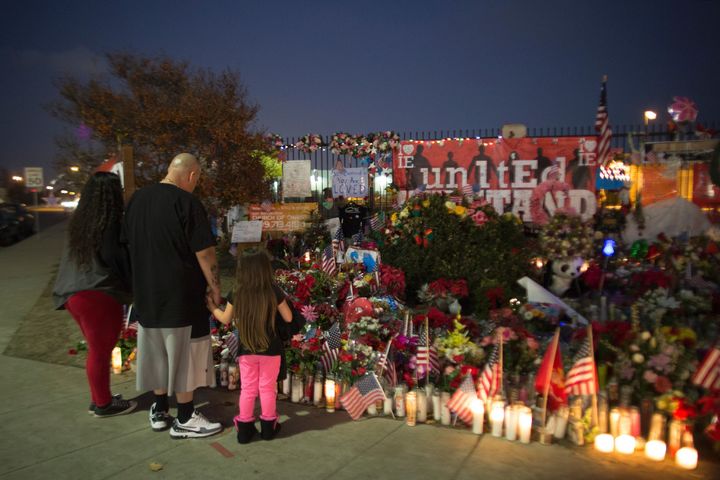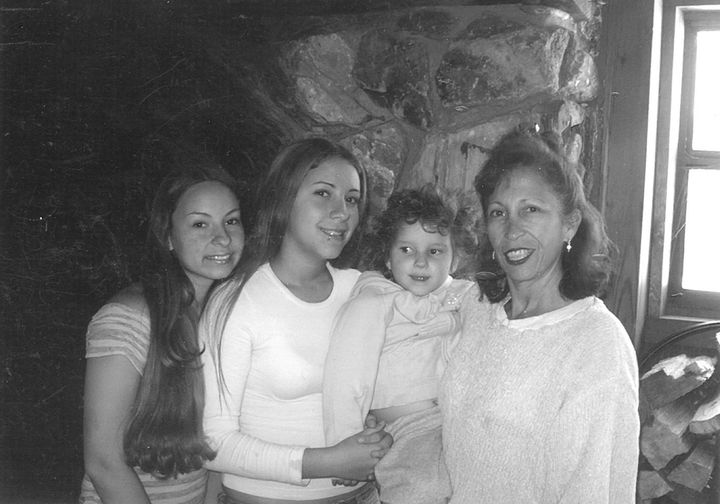
In November 2005, Linda Miers’ 16-year-old daughter, Melanie, was killed in a drive-by shooting outside a party in her hometown of San Bernardino, California.
Nine years later, Melanie’s 26-year-old sister, Michelle, was stabbed to death in the city, leaving behind two young children.
San Bernardino was shoved into the national spotlight on Dec. 2, 2015, when a terror attack in the city claimed 14 lives. But long before that mass shooting, the economically depressed city was ground zero for the country’s gun violence epidemic.
Most Americans killed by guns aren't involved in mass shootings that dominate headlines -- instead, they're victims of personal disputes, domestic violence incidents and gang wars.
San Bernardino has long had one of the highest murder rates in Southern California. Thanks to years of decline, the city remains well below its peak rate of the 1990s. But in recent months, the number of people killed in the city has once again swung upward.
Now the city government is partnering with community groups to test innovative violence prevention tactics they hope will spare more residents the grief experienced by people like Linda Miers.
Searching For Solutions With Limited Resources
There have been 27 murders in San Bernardino so far this year, according to the city's police department. That number represents more than a two-fold increase from this point last year, when there had been 13 murders in the city.
There were 44 total murders in the city last year, including the 14 people killed in the December massacre.
That's a significant number of murders for a municipality with some 215,000 people. There were 352 murders last year in New York City, which has more than 8 million residents -- an admittedly low figure for a city of its size. If San Bernardino had the same murder rate, it would have seen fewer than nine murders in 2015.
“It is hard to say exactly why we are having a crime spike,” said Lt. Richard Lawhead of the San Bernardino Police Department, noting that such things as inadequate housing options and high poverty rates may have contributed to the increase.
“If [young people] are not involved in any productive and positive activities, they are just fooling around -- and then the people influencing them are not as good.”
- Sergio Luna, Inland Congregations United for Change
San Bernardino was once seen as a model middle-class city, winning the National Civic League’s “All-America City” designation in 1976. The award, which celebrates "civic innovation," recognizes communities that demonstrate creative problem-solving.
But the town went into an economic tailspin after a large Air Force base and major industrial employers closed in the 1980s and 1990s. The low cost of living also attracted people escaping the high rents of Los Angeles and Orange County, straining the town’s resources.
About one-third of San Bernardino residents live in poverty now, according to the Census Bureau. It's a rate rivaling that of Detroit and Cleveland, the country’s most impoverished large cities.
San Bernardino also went through bankruptcy in 2012, and the police force still hasn't recovered. The city's tight finances continue to limit spending on other services like parks and libraries.
Sergio Luna, a community organizer for Inland Congregations United for Change, a religious grassroots organization that focuses on poverty and other social challenges, said he drives his children to parks outside the city because the ones in San Bernardino are in such poor condition.
“There is nothing for young people to do in San Bernardino,” Luna said. “If they are not involved in any productive and positive activities, they are just fooling around -- and then the people influencing them are not as good.”
“Why do we have such a heavy emphasis on suppression and no resources to serve people’s needs in a way that will prevent violence?”
- Tom Dolan, Inland Congregations United for Change
To combat the recent crime spike, the city has collaborated with San Bernardino County on Operation Safe Streets, a crime-fighting task force that the city police chief says has already helped get guns off the streets.
But city officials and community leaders are most hopeful about a potential $600,000 grant from California’s Board of State and Community Corrections. The city has committed to matching a portion of the funds, either in cash or through in-kind contributions.
This funding, on which the state will announce a decision by July 1, would be used in part to implement Operation Ceasefire, a violence prevention program that originated in Boston in the mid-1990s.
The program marshals public and nonprofit resources to identify the small group of young men -- disproportionately from communities of color -- most at risk of shooting someone or being shot. Civic leaders, including law enforcement agents, then sit down with the high-risk young men and attempt to steer them away from crime. Typically they do this by reminding the young people of the alternatives available to them and offering help, but they also warn them that they have been identified and will be prosecuted if they do not abandon their risky behaviors.
Communities that have tried variations of this program -- including the California towns of Oakland, Stockton and Richmond -- have seen marked reductions in gun violence.
The grant would also provide funds for an initiative to build trust between police officers and community members, said Chris Lopez, the chief of staff to San Bernardino's mayor. He said that would likely entail law enforcement agents having more face-to-face interactions with people in the city, including through the pre-existing "coffee with a cop" community meetings.
Inland Congregations United for Change worked with the city on the grant application and stands to receive a share of its funding, Lopez said. Though imperfect, the grant represents a positive step away from a largely punitive approach to policing, said Tom Dolan, the group’s executive director.
“Why do we have such a heavy emphasis on suppression and no resources to serve people’s needs in a way that will prevent violence?” he asked.
“The dominant narrative is that the problem with cities like San Bernardino is that it has the wrong kind of people,” he added. “The other narrative is that the people are what is needed to make the city, state and country better, but we need to invest in them.”
Dolan believes the city government and police department have been relatively slow to embrace crime-fighting techniques that focus on the root causes of violence.
He leads residents in bimonthly night walks around some of the city's toughest neighborhoods. These events are meant to show solidarity with those who have been affected by violence -- and to protest inadequate government management of the situation.
“These night walks, without us saying it, put pressure on the police,” he said.

Finding Comfort In Community
Linda Miers left San Bernardino shortly after her second daughter’s death, seeking relief from painful memories and the city’s social problems. She now raises her 14-year-old daughter, Natalie, in nearby Redlands.
Every day is a struggle to overcome the lingering grief from the loss of her first two daughters.
“You get to the point where you say, ‘I just don’t care,’” Miers said. “But then, I have another daughter, so I need to care.”
Miers spends her weekdays working for the county, and finds solace in her Catholic faith and helping others. She is a eucharistic minister at San Bernardino’s Our Lady of the Rosary Cathedral, where she also helps feed needy and homeless people once a month. Michelle's two children, who live with their father, have attended Sunday school at the church.
“People who are alcoholics have Alcoholics Anonymous meetings. Drug addicts have their meetings. You don’t have enough meetings for parents of murdered children to attend.”
- Linda Miers
Miers recently took over as head of the Inland Empire chapter of Parents of Murdered Children. She wants to help other people who have lost children to violence.
“People who are alcoholics have Alcoholics Anonymous meetings. Drug addicts have their meetings,” she said. “You don’t have enough meetings for parents of murdered children to attend.”
The first couple of meetings she held in San Bernardino were sparsely attended. Miers believes some parents are so wary of crime in the city that they would rather not even go to meetings there. She plans to attend a training workshop in Orange County next year that she hopes will help her build a stronger local chapter for the organization.
Miers, who used to collaborate regularly with Dolan, is supportive of the idea of Operation Ceasefire. But she's taking a break from the big-picture, anti-violence policy work. Work, family and community leadership keep her active enough.
Miers isn't sure what, if anything, the next president would be able to do to help communities like hers. She has little faith that stricter gun laws, for instance, will make a meaningful difference, arguing that criminals who want guns will still find a way to get them.
“They could fund more money for police officers to walk streets and drive around the neighborhoods,” Miers offered. “In San Bernardino, [foot patrols] can be dangerous.”
